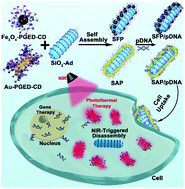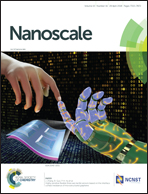Multifunctional hybrids with versatile types of nanoparticles via self-assembly for complementary tumor therapy†
Abstract
Self-assembly is a promising method for the construction of multifunctional nanohybrids for biomedical application. In this work, self-assembled multifunctional nanohybrids with a controllable disassembly property have been successfully fabricated. By modification with cyclodextrin (CD)-decorated ethylenediamine-functionalized poly(glycidyl methacrylate) (PGED), CD groups and polycations were conjugated onto Au nanorods (Au NRs) or Fe3O4 nanoparticles (denoted as Au-PGED-CD or Fe3O4-PGED-CD), and different SiO2@Fe3O4-PGED (SFP) or SiO2@Au-PGED (SAP) nanohybrids were readily fabricated by the host–guest interaction between Au-PGED-CD or Fe3O4-PGED-CD and adamantyl (Ad)-functionalized chiral silica NRs under mild conditions. The DNA condensation ability of the polycation, the photothermal effects of Au NRs or Fe3O4 nanoparticles, as well as the unique structure of chiral silica NRs were integrated into one nanohybrid. Such nanohybrids have high gene transfection efficiency and low cytotoxicity. The photothermal effects of the nanohybrids could be utilized for photothermal therapy, and also could induce the disassembly of the nanohybrids, which is beneficial for DNA release. The nanohybrids with good transfection performance and excellent photothermal effects were further applied for multimodal therapy. This work presents a flexible strategy for the fabrication of multifunctional nanoplatforms with integration of the advantages of various types of nanoparticles.



 Please wait while we load your content...
Please wait while we load your content...